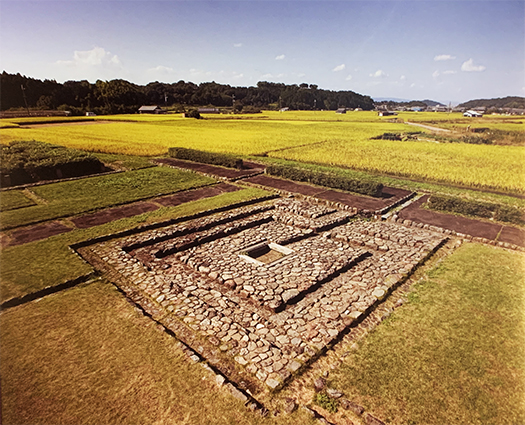

探れば探るほどに日本の国の「まほろば」の思いを強める飛鳥宮。
遠隔地からの訪問機会でもあり橿原考古博物館では疑問の湧き出るに任せ
学芸員の方に申し訳なかったけれど質問攻めさせていただいた。
ご丁寧に対応していただき感謝そのものでした。
主に関心を持った「苑池」のことについて質問したのですが、
まだまだ定かになっていない点も多いようでした。
これからも折に触れて疑問解決と深掘りに努めていきたいと思います。
で、資料の類をいくつか購入させていただいた中に
同博物館・主任学芸員の鶴見泰寿氏の「古代国家形成の舞台」書籍があり、
そちらを読み進めていて驚きの記述一節があって目が点になった。
「飛鳥宮は694年12月の藤原宮遷都にともなって廃絶するが、
施設の解体作業時にきれいに土をかぶせて跡地整理され、その後は
耕作地として現代まで使われ続けた」とのさりげない記述。
おお、であります。
王宮建築が廃棄されるときどういう運命をたどるのかというのは
それほど情報を聞いたことがなかったけれど、
さすがに考古学の博物館として当然そういう研究もされているのですね。
今日わたしたちは明日香町にはのどかな農村風景を見ている。
しかしその被覆のほんの少し下にまるでタイムカプセルを意図したように
日本史の重要な王宮跡が秘められている。
王権としてその廃絶に当たってそういう配慮を見せていた。
易姓革命の中国では、王権の交代に当たっては血生臭い戦争が通常で
多くの宮廷建築は革命戦争で焼失するのが一般的。
また多くは権威的な「基壇建築」であり、基壇は石積み構造であることから
移転が意図されにくかったという事情も大きいのだろう。
またそもそも建築自体も石造のヨーロッパでも移転という発想に乏しい。
結果、「廃墟」という形でうち捨てられたようになってしまう。
どうもこのことは日本の王宮建築が基本的に木造の掘っ立て柱建築であり
移設建築することが容易に可能である事情が与っていると思われた。
同書中では王宮建築解体時の材の扱いで腐朽度合いに応じて
残す材と廃棄する材とが仕分けされている事実まで確認されている。
移転させて使う材はていねいに掘り起こされているけれど、
腐朽の進んだ材は切断されて根元部分の一部が残置されている事実。
その柱穴などに対して「黄褐色の土」を入れて整地し、その上で
「地面を覆って」土を被覆させている状況が確認されているというのです。

結果として、この飛鳥宮は1400年の時を超えてタイムカプセル保存された。
こうした跡地について、農耕に供されて永年保存されてきた。
なにやらわたしには、日本の王権の特性をそこに見る思い。
この飛鳥で聖徳太子は「和を以て貴しとなす」と政治方針を示したが
権威主義・強権主義ではなく、より「民主」的な姿勢を認めうる。
もちろんこれが王権の「意図的」施策だったとまでは思わないけれど、
世界でも特異な民と王権の関係性に建築スタイルが関与していると思えるのです。
English version⬇
Asuka Palace “Site Arrangement” Time Capsule Exploration of Asuka, Nara – 10
The wooden construction method, which allows for the recyclability of construction materials, may have strongly influenced the relationship and culture between the Japanese royalty and the people. …
The more we explore the Asuka Palace, the more we are reminded of the “Mahoroba” of the Japanese nation.
As I was visiting from a remote place, I let my questions flow freely at the Archaeological Museum of Kashihara.
I am sorry to say that I asked a lot of questions to the curator of the museum.
I was very grateful to the curators for their courteous response.
I mainly asked questions about the “garden pond” that I was interested in.
It seemed that there were still many points that had not yet been clarified.
I would like to continue my efforts to solve questions and dig deeper from time to time.
I was able to purchase some of the materials from the museum, and I found the following
I was surprised to read a book titled “The Stage of Ancient State Formation” written by Yasutoshi Tsurumi, chief curator of the museum.
As I was reading the book, there was a surprising passage in the book that made my eyes water.
As I was reading the book, I was struck by a surprising passage: “Asuka Palace was closed down in December 694, when the capital was moved to Fujiwara no Miya.
The Asuka Palace was abandoned in December 694 when the capital was moved to Fujiwara no Miya, but the site was cleared and covered with soil when the facilities were dismantled.
The site was then cleared and the land continued to be used as cultivated land until the present day.
Oh, yes.
I had never heard much information about the fate of royal palace buildings when they are discarded.
I had never heard that much information about the fate of palace buildings when they were discarded.
But as a museum of archaeology, it is natural that they are doing such research.
Today, we see a peaceful rural landscape in Asuka Town.
However, just a little below the surface, as if it were intended to be a time capsule, there are the ruins of an important royal palace in Japanese history.
The ruins of an important royal palace in Japanese history is hidden just a little below that covering, as if it were intended to be a time capsule.
The royal court showed such consideration in its abolition.
In China, where the revolutionary revolution took place, bloody wars were the norm in changing kingdoms.
Many court buildings were generally destroyed by fire in revolutionary wars.
Many of them were authoritative “keystone buildings,” and since the keystones were masonry structures, they were not intended to be moved.
It is likely that the relocation of these buildings was not intended.
Also, many of them are authoritative “platform buildings,” and since the platforms are masonry structures, it was probably difficult for them to be intended for relocation.
The fact that the platforms are masonry structures may also be a major reason why relocation was not intended.
In Europe, where architecture is also built of stone, the idea of relocation is not very common.
As a result, the buildings are abandoned in the form of “ruins.
This is apparently due to the fact that Japanese royal palaces are basically wooden buildings with dugout pillars, which makes it easy to relocate them.
This is apparently due to the fact that Japanese royal palace buildings are basically wooden, dugout-pillar structures that can be easily relocated.
In the same book, it is stated that the handling of materials at the time of demolition of the royal palace building depends on the degree of decay.
The book even confirms the fact that the materials used in the demolition of the palace were sorted into two categories according to the degree of decay.
The timber that was to be moved was carefully excavated, while the timber that was to be discarded was cut down.
The fact is that the timbers that are to be used for relocation are carefully dug up, while those with advanced decay are cut down and a part of the root part is left behind.
The post holes are then covered with “yellowish-brown soil” and the ground is cleared.
The soil was then “covered” with a layer of soil.
As a result, this Asuka Palace was preserved as a time capsule over a period of 1,500 years.
This site has been used for agriculture and preserved for many years.
I feel as if I am seeing the characteristics of Japanese kingship there.
In Asuka, Prince Shotoku set forth his political policy of “Harmony is the key to nobility.
This is not authoritarianism or authoritarianism, but a more “democratic” attitude.
Of course, I do not think this was an “intentional” measure of the royal authority.
but it seems to me that the architectural style involved a relationship between the people and the royal power that is unique in the world.
Posted on 4月 25th, 2022 by 三木 奎吾
Filed under: 住宅マーケティング, 日本社会・文化研究







コメントを投稿
「※誹謗中傷や、悪意のある書き込み、営利目的などのコメントを防ぐために、投稿された全てのコメントは一時的に保留されますのでご了承ください。」
You must be logged in to post a comment.